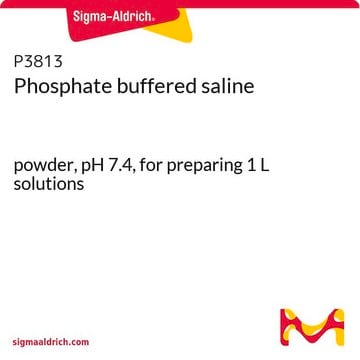We have no information on using this product for oxidase test. Product No. T3134, N,N,N′,N′-Tetramethyl-p-phenylenediamine dihydrochloride is commonly used to perform the oxidase test for the colorimetric identification of pathogenic and non-pathogenic bacteria.
P6001
p-Phenylenediamine
98% (GC)
Sinónimos:
1,4-Benzenediamine, 1,4-Diaminobenzene, 1,4-Phenylenediamine
Seleccione un Tamaño
Seleccione un Tamaño
About This Item
Productos recomendados
densidad de vapor
3.7 (vs air)
presión de vapor
1.08 mmHg ( 100 °C)
descripción
anti-fade reagent
Ensayo
98% (GC)
bp
267 °C (lit.)
mp
138-143 °C (lit.)
cadena SMILES
Nc1ccc(N)cc1
InChI
1S/C6H8N2/c7-5-1-2-6(8)4-3-5/h1-4H,7-8H2
Clave InChI
CBCKQZAAMUWICA-UHFFFAOYSA-N
¿Está buscando productos similares? Visita Guía de comparación de productos
Categorías relacionadas
Aplicación
- to evaluate its sensitization potential in vitro in langerhans-like dendritic cells and autologous T cells[1]
- to treat the dorsal sides of the ears of mice, to study its systemic immunological effects[2]
- in glycerol to coverslip coronal sections in the attempt to count Aβ plaques[3]
Anti-fade reagent is added to the mounting medium in fluorescence microscopy to retard photobleaching of fluorescein and other fluorescent dyes.
Acciones bioquímicas o fisiológicas
Precaución
Palabra de señalización
Danger
Frases de peligro
Clasificaciones de peligro
Acute Tox. 3 Dermal - Acute Tox. 3 Inhalation - Acute Tox. 3 Oral - Aquatic Acute 1 - Aquatic Chronic 1 - Eye Irrit. 2 - Skin Sens. 1 - STOT SE 1 Oral
Órganos de actuación
Kidney,Heart,Musculo-skeletal system
Código de clase de almacenamiento
6.1C - Combustible acute toxic Cat.3 / toxic compounds or compounds which causing chronic effects
Clase de riesgo para el agua (WGK)
WGK 3
Punto de inflamabilidad (°F)
230.0 °F - closed cup
Punto de inflamabilidad (°C)
110 °C - closed cup
Equipo de protección personal
Eyeshields, Faceshields, Gloves, type P2 (EN 143) respirator cartridges
Elija entre una de las versiones más recientes:
¿Ya tiene este producto?
Encuentre la documentación para los productos que ha comprado recientemente en la Biblioteca de documentos.
-
May I ask if I can use P- phenylenediamine for oxidase test
1 answer-
Helpful?
-
-
What is the solubility of p-Phenylediamine, Product P6001?
1 answer-
This product is soluble in ethanol at a concentration of 50 mg/mL, with heating. A clear red to brown solution is observed.
Helpful?
-
-
What is the Department of Transportation shipping information for this product?
1 answer-
Transportation information can be found in Section 14 of the product's (M)SDS.To access the shipping information for this material, use the link on the product detail page for the product.
Helpful?
-
-
For what applications is p-Phenylediamine, Product P6001, used?
1 answer-
This is an antifade reagent that is used as a fluorescent stabilizer. Do not confuse the p-phenylenediamine with o-phenylenediamine, which is used as a peroxidase substrate in ELISA procedures.
Helpful?
-
-
What is the working concentration for p-Phenylediamine, Product P6001, when used as an antifade agent?
1 answer-
J. Immunological Methods, 43, 349 (1981) describes a solution that will reduce the fading of fluorescent materials. The recipe for this solution is: "Add 10 mL of phosphate-buffered saline (0.01 M PO4, pH 7.4 in 0.15 M NaCl) containing 100 mg of p-phenylenediamine to 90 ml of glycerol. The final pH should be adjusted to approximately 8.0 with 0.5 M carbonate-bicarbonate buffer (pH 9.0)".
Helpful?
-
Active Filters
Nuestro equipo de científicos tiene experiencia en todas las áreas de investigación: Ciencias de la vida, Ciencia de los materiales, Síntesis química, Cromatografía, Analítica y muchas otras.
Póngase en contacto con el Servicio técnico








